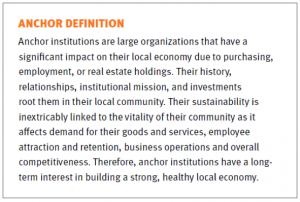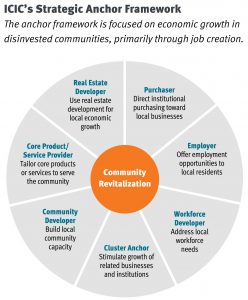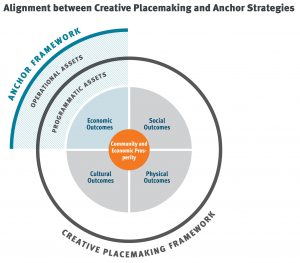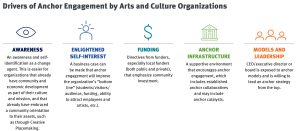Back

Blog
Overlooked No More: Advancing the Anchor Framework to Arts and Culture Organizations
Arts and culture organizations can play a more powerful role in shaping community development in low-income communities by adopting and adapting key strategies used by traditional ‘anchor’ organizations like hospitals and universities. Arts and culture organizations already make important contributions to the vitality of their communities, and deserve a seat at community development tables.
However, a new report by the Initiative for a Competitive Inner City (ICIC) that was supported by The Kresge Foundation’s Arts & Culture Program — The Overlooked Anchors: Advancing a New Standard of Practice for Arts and Culture Organizations to Create Equitable Opportunity in America’s Cities — asks the sector to do more to drive more equitable, economic growth in their communities.

A Strategic Approach for Community Revitalization
The report applies to arts and culture organizations the formal framework that ICIC developed to guide community development efforts of other types of organizations (e.g., hospitals, universities and corporations).

The report explores how the anchor framework can be positioned within Creative Placemaking to spur greater interest by arts and culture organizations in expanding opportunity in communities of low income. Where Creative Placemaking lifts up arts and culture as forces of community and economic prosperity, primarily through programmatic channels, the anchor framework provides specific operational strategies by which arts and culture organizations can explicitly drive local economic growth.
The Kresge Foundation, among others, advances a Creative Placemaking approach that is anchored in equity, incorporating a commitment to expanding opportunities for people with low incomes in disinvested communities, which is consistent with ICIC’s anchor framework. Arts and culture organizations that are able to connect the two approaches will create more equitable outcomes in their communities.

Arts and Culture Organizations Already Leaning in as Anchors
Organizations engage as anchors in different ways, finding strategies that represent their particular assets and fit their missions. Hospitals do not have the same set of strategies as universities, for example. Likewise, within the diverse arts and culture sector, different types of organizations need to develop different models for engagement. The report profiles four types of large arts and culture organizations engaged as anchors: a school of art and design, a performing arts center, a children’s museum and a fine arts museum. Thus, it illuminates engagement pathways for different types of arts and culture organizations. The four organizations profiled include:
- Maryland Institute College of Art in Baltimore
- The Adrienne Arsht Center for the Performing Arts of Miami-Dade County
- The Children’s Museum of Indianapolis, and
- The Cleveland Museum of Art
The report also highlights five other large arts and culture organizations that offer leading practices or provide interesting examples of the journey towards anchor engagement:
- New Museum of Contemporary Art in New York City
- The Cleveland Institute of Art
- Los Angeles County Museum of Art
- The Smithsonian Institution in Washington, D.C., and
- Newfields in Indianapolis
The anchor approach was created for large organizations—specifically universities and hospitals. The strategies create significant economic activity because of the scale of these organizations. However, the impact of smaller organizations on the neighborhoods they serve can be just as significant, and nowhere is this truer than in the arts and culture sector. Our research finds that small and mid-sized arts and culture organizations are also playing important roles in anchor ecosystems, with some serving as “anchor catalysts” for the broader arts and culture sector. Their influence and community partnerships help remove barriers to anchor engagement and their participation in anchor collaboratives demonstrate a path forward to anchor engagement for large arts and culture organizations. The report discusses the anchor engagement of the following four organizations:
- Project Row Houses in Houston
- The Guadalupe Cultural Arts Center in San Antonio
- Movimiento de Arte y Cultura Latino Americana (MACLA) in San Jose, and
- Ashé Cultural Arts Center in New Orleans
By surfacing diverse anchor strategies and practices, the report points to accessible entry points to anchor engagement for all types and sizes of arts and culture organizations. Further, anchor strategies are meant to redirect existing resources, instead of requiring additional resources, towards community benefit. For example, large arts and culture organizations already foster economic growth by purchasing goods and services. To help grow local businesses and create jobs, they can leverage this role by implementing strategies to expand purchasing from local businesses.
Driving More Arts and Culture Anchor Engagement
While all large arts and culture organizations are positioned to act as anchors alongside hospitals, universities and corporations, clearly not all are doing so. The report posits that five primary factors drive anchor engagement among arts and culture organizations. It is some combination of these drivers, not a single factor, that is already moving some arts and culture organizations to commit to a robust anchor strategy.

A Call to Action
This report is not meant to suggest that all arts and culture organizations should develop robust anchor strategies—to do so would feel out of reach for many. Engaging as an anchor is not a binary proposition—there are different degrees of engagement. In the report, we identify how arts and culture organizations can leverage their particular assets to implement specific anchor strategies.
The report concludes by offering a set of recommendations to spur the adoption of more anchor strategies by arts and culture organizations. It includes actions for arts and culture organizations, private and public sector funders and city leaders:
1. Build awareness throughout the arts and culture sector
Organizations that have adopted robust Creative Placemaking practices or other community impact strategies may be the most likely to adopt anchor strategies. Other arts and culture organizations may first need to realize that they should play a role in equitably fostering local economic growth and creating expanded opportunity in communities of low income.
2. Secure interest and goal alignment with organizational leaders and trustees
At the core of most successful anchor engagement is a compelling business case that what is good for the organization’s community is also good for the organization’s long-term interests. This may include building a local audience, attracting more funding or attracting and retaining great employees.
3. Build the capacity of arts and culture organizations to drive inclusive, equitable growth
The leadership (current and future) of arts and culture organizations need examples of specific, proven anchor strategies and technical assistance to help them develop robust, effective anchor engagement plans for their organizations. They also may need training on inclusive, equitable development to better understand what it is and why it is important for their community as well as for their organizations.
4. Change the narrative about arts and culture organizations as anchors
Anchor collaboratives and economic development agencies should expect the same commitment to economic development from large arts and culture organizations as they do from other types of anchors (universities, hospitals and corporations) and bring them to the same planning tables. The other anchors may wield significantly more economic power, but large arts and culture organizations have enough scale to transform their communities.
5. Consider allocating funding to anchor engagement
Federal, national and local arts and culture funders should consider supporting meaningful anchor engagement by arts and culture organizations. This could include supporting specific anchor strategies or anchor catalyst activities.
This report is primarily a call to action for arts and culture organizations and their funders. We hope city leaders, community and economic development planners and the anchor field will also pick up the report – to change their perspective and start to consider arts and culture organizations as anchor institutions alongside hospitals, universities and corporations.
Read the full report: The Overlooked Anchors: Advancing a New Standard of Practice for Arts and Culture Organizations to Create Equitable Opportunity in America’s Cities. To inquire about our work, please contact Kim Zeuli at kzeuli@icic.org.
